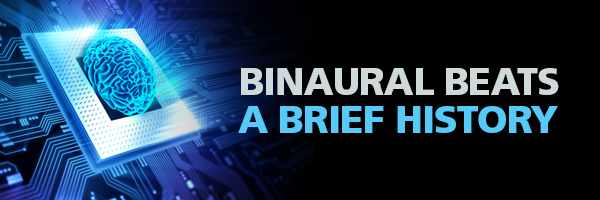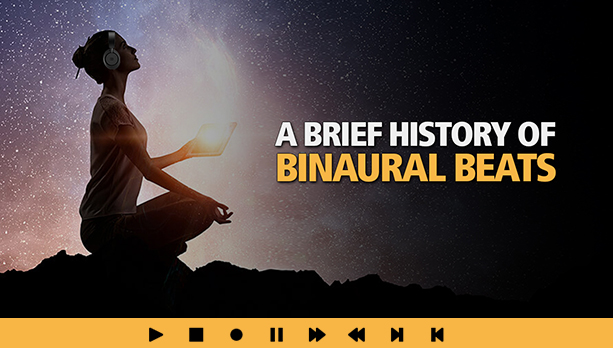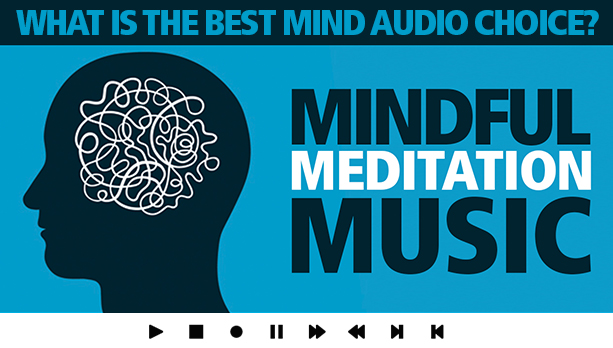Brief History of Binaural Beats

Do you integrate binaural beats into your modern wellness lifestyle? Let’s start with a brief history of binaural beats. We will discuss the discovery of binaural beats and research on binaural beats. Finally, we will cover uses for binaural beats.
Brief History of Binaural Beats
Binaural beats, as used in mindfulness therapy, is an emerging form of active audio treatment in which both ears process two slightly different perfectly-tuned frequencies, but perceive them as one pulsating tone (re the binaural beat). Above all, what makes these binaural beats so unique, and how were they discovered?
Science Behind Binaural Beats
In our brief history of binaural beats, we will certainly cover the discovery of binaural beats and how they came to be. First of all, before delving into the currently available research on binaural beats, let’s cover the main uses for this powerful audio therapy. Most noteworthy, research shows that when a person listens to binaural beats, their levels of cognition change. Even more, these changes happen because the binaural beats trigger explicit systems within the brain. An electroencephalogram (EEG) that records electrical brain activity shows that people who use a specific type of binaural therapy (tested against the iDoser.com brand) had measurable changes in their EEG output. Consequently, how does this relate to binaural beats and meditation?
Technology Behind Binaural Beats
Most noteworthy, binaural beats require a complex sequence of professionally tuned frequencies to be effective. Even more, there are loads of amateurs on YouTube, making some laughably out-there claims. In contrast, real (proven, successful, and professional) binaural beats require ample research and testing. Hence, you won’t get that quality on YouTube. Furthermore, our brief history of binaural beats covers the creation, but what about current technology? Research on binaural beats has certainly given us many uses for binaural beats. Even more, free solutions like the Mind Audio Platform make it easy to try professional binaural beats. Also, when you are ready to supplement, modern apps render pure-tone binaural beats in real-time. We have certainly come a long way since the discovery of binaural beats.
Discovery of Binaural Beats
First of all, binaural beats are not new technology. While they were commercialized and bought into the mainstream many decades ago by the iDoser.com company, they were discovered long before that. iDoser certainly did refine the technology for the masses and made it readily available, but they did not invent binaural beats. Who did?
Founder of Binaural Beats
Most noteworthy, you can’t cover the brief history of binaural beats without talking about the great Heinrich Wilhelm Dove (1803–1879). The discovery of binaural beats started in 1839 when the first actual research on binaural beats took place. Consequently, without Heinrich Wilhelm Dove there wouldn’t be so many uses for binaural beats. He is certainly the pioneer of binaural beats. The discovery of binaural beats in 1839 truly happened when Heinrich Wilhelm Dove published his findings on binaural beats in the scientific journal Repertorium der Physik. Furthermore, it wasn’t until 1973 when Gerald Oster published the article “Auditory Beats in the Brain” that people really started to notice. Likewise, Oster saw binaural beats as a powerful tool for cognitive and neurological research. Rather, it wasn’t for many years that they become mainstream and commercialized by the iDoser company.
Commercialization of Binaural Beats
Many decades ago, the iDoser company took all available research on binaural beats and released a commercial product utilizing the technology. It went viral. Hence, the brief history of binaural beats would not be complete without mention of iDoser. Most noteworthy, they are associated with the commercialization of binaural beats. Consequently, they are not part of the discovery of binaural beats, but the push towards mainstream use. Even more, their products offer solutions that cover the full range of uses for binaural beats. Furthermore, they are the originator of the free Mind Audio Platform, and their mobile app is the most used binaural beat app available. Hence, when people talk about binaural beats, they often use the terms “idose, idosing, or idoser” to describe what is essentially a commercial product utilizing the technology discovered in 1839.
Research on Binaural Beats
First of all, there is a lot of research out there on binaural beats. While this might certainly sound boring, going through science-babble on audio stimulus – there are some points we need to touch on. Active mind audio is tuning your brainwaves through advanced induction. Hence, every user should be aware of the psychology of binaural beats.
Psychology of Binaural Beats
Above all, the brief history of binaural beats begins when you first put on the headphones and melt away. Since the discovery of binaural beats by Heinrich Wilhelm Dove, the refinement of research by Gerald Oster, and commercialization by iDoser.com – they have become the most popular form of meditation audio. Likewise, there is a lot of valid research on binaural beats. Hence, understanding the science will help us to better grasp the many uses for binaural beats.
Furthermore, the psychology is polar depending on the perceived soundwave. Above all, binaural beats are theorized to boost the brain. They might trigger a state of active alertness and cognition. Likewise, they may trigger actual hormonal changes, like the production of melatonin. Furthermore, the effects depend on the professional composition of the active audio. It is for this reason that you will see binaural beats used by insomniacs and students alike. Above all, the uses are many.
Binaural Beats and The Human Mind
The brief history of binaural beats makes a stop inside the human mind. Cognition is certainly one of the many popular uses of binaural beats, but why? First of all, the discovery of binaural beats happens on a personal, spiritual, and meditative level. Hence, it is something YOU need to experience. Likewise, all the research on binaural beats won’t prepare you for that moment when you reach Zen, deeply entrained inside an iDoser binaural beat session. We can list hundreds of uses for binaural beats, but it won’t compare to your first time using them. Rather, we should touch on two big ones. Above all, binaural beats have taken over meditation on a truly astounding level. Unfortunately, they have also become a joke with scam YouTube channels posting fake sessions calming to be binaural beats. In contrast, what are some high-level uses for binaural beats?
Uses for Binaural Beats
There are many valid uses for binaural beats. Some are real. Improved sleep, lucid dreaming, memory and cognition, and sexual performance are just a few of the many uses for binaural beats. However, many YouTube scammers are making laughably false claims. Let’s clear the air.
Binaural Beats for Meditation
First of all, before the discovery of binaural beats, active audio therapy was in the infancy. Even more, through the development of binaural beats, people slowly realized how effective this new form of audio therapy was for meditation. Hence, as research on binaural beats eventually showed, they are incredibly useful for all sorts of mindfulness. Sleep therapy, meditation, cognitive thought, data processing, and sexuality are all supplemented with the use of binaural beats – and much more. The uses for binaural beats are certainly many. Hence, if your life requires reduced stress, less anxiety, increased focus, and improved motivation, then binaural beats might be a worthy addition to your wellness lifestyle.
Binaural Beats on YouTube
There is a lot of research on binaural beats available. Hence, we can’t cover it all in our brief history of binaural beats. Even more, the discovery of binaural beats is genuinely fascinating. In contrast, some bad players on YouTube have been giving active mind audio a lousy name. First of all, this technology can not cure cancer, change your physical attributes (like eye color, weight, or height), or any of the other false claims made by YouTube scammers.
Furthermore, there are many VALID uses for binaural beats, including mindfulness, sleep, and cognition. Remember, effective binaural tracks are complicated and take time to produce and test. Hence, a single “real” binaural beat composition can take months to craft. Most noteworthy, in the case of iDoser.com, some of their sessions have famously taken years to create. Hence, not inductive to YouTube. Viewer, be wary. Fake active audio can hinder or reverse the effects of professional content.
Binaural beats have certainly become essential to the mindful lifestyle. Professional and effective solutions (like those available from iDoser.com) are the modern-day norm. In contrast, stay away from the surge of foreign scammers and teenagers posting malicious active mind audio content on platforms like YouTube. Furthermore, are you ready for this new form of meditation music?
CLICK HERE TO TRY BINAURAL BEATS FREE
TO ALL OUR READERS, today we humbly ask you to help our little blog. For over ten years now, BinauralBlog.com has been producing fantastic mindfulness articles. We do not beg for donations, use any intrusive popups, sell any form of user data, or fill our content with ads. How do we sustain ourselves? We need shares, plain and simple. The time has come for us to make a simple request. Please, if you enjoyed this article and want us to keep producing content - use any (or all) of the CIRCULAR SHARE BUTTONS ABOVE to help support our little blog. Thank you from the Binaural Blog, Founder & Team





I was suffering from some really bad depression for years. I can’t say for sure that binaural beats got me out of it. They were one of the many things I tried though and still use. I am doing much better these days. Anyone else have success using for depression?
I always thought binaural beats were discovered only a few decades ago. They have been around for hundreds of years I guess.
Not only binaurals but we as people have been attracted to ambient sounds since the beginning of time. The gentle wash of waves, the crackle of a fire, the sound inside the womb. Binaurals make sense when you look at the big life picture.
I found this very informative. Would love to see another article like this on subliminals. I know YouTube is now loaded with fake scam subliminal makers but I mean real subliminal use like in marketing, tv, movies, and politics. What do you think?
I am a musician and I have integrated binaural sub tracks in my songs since my second album. They are nothing you would notice, but there are there on a sub-level. I worked with the i-doser company in the early days to nail the feel down but now I do them on my own using their original research